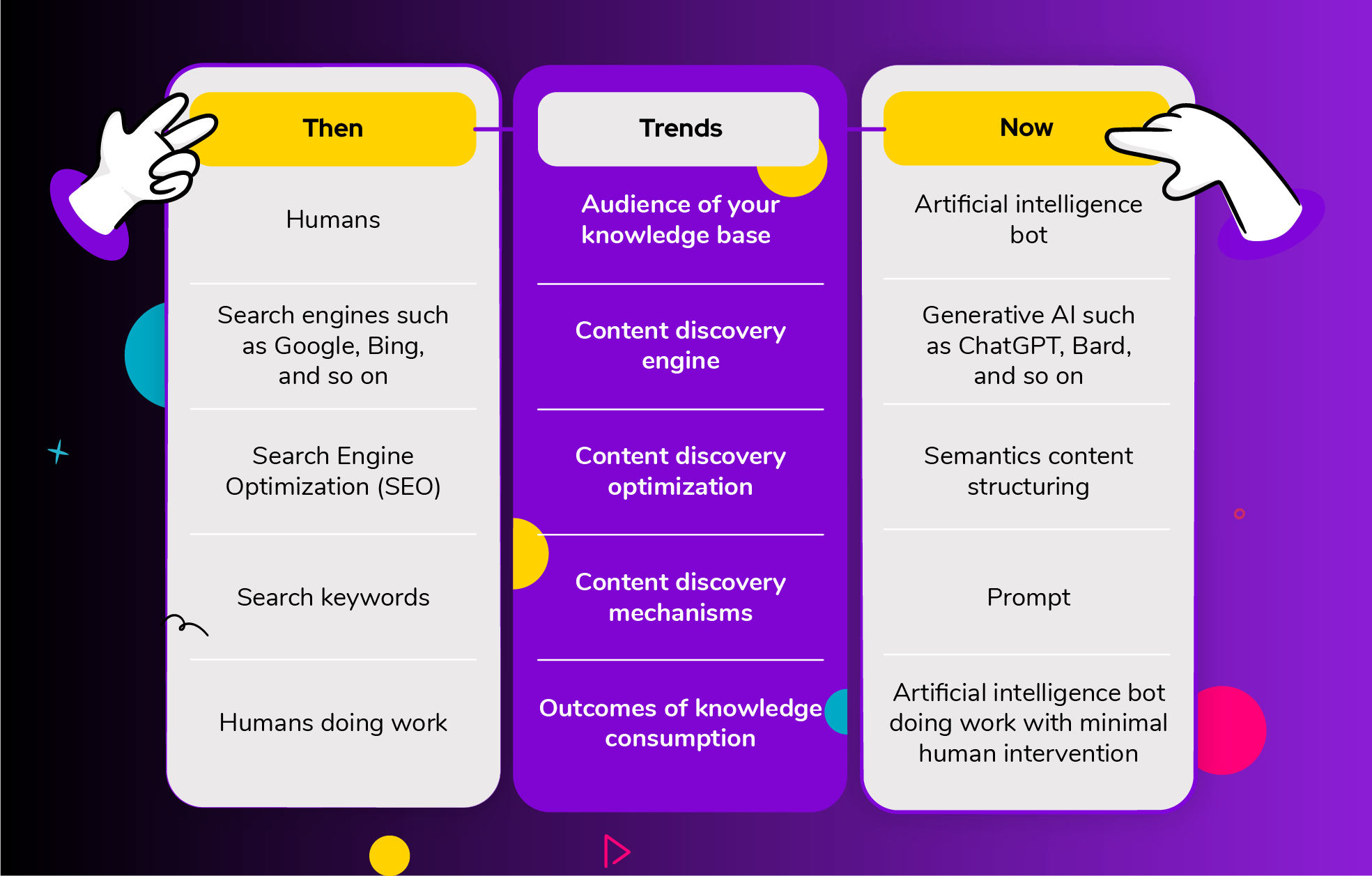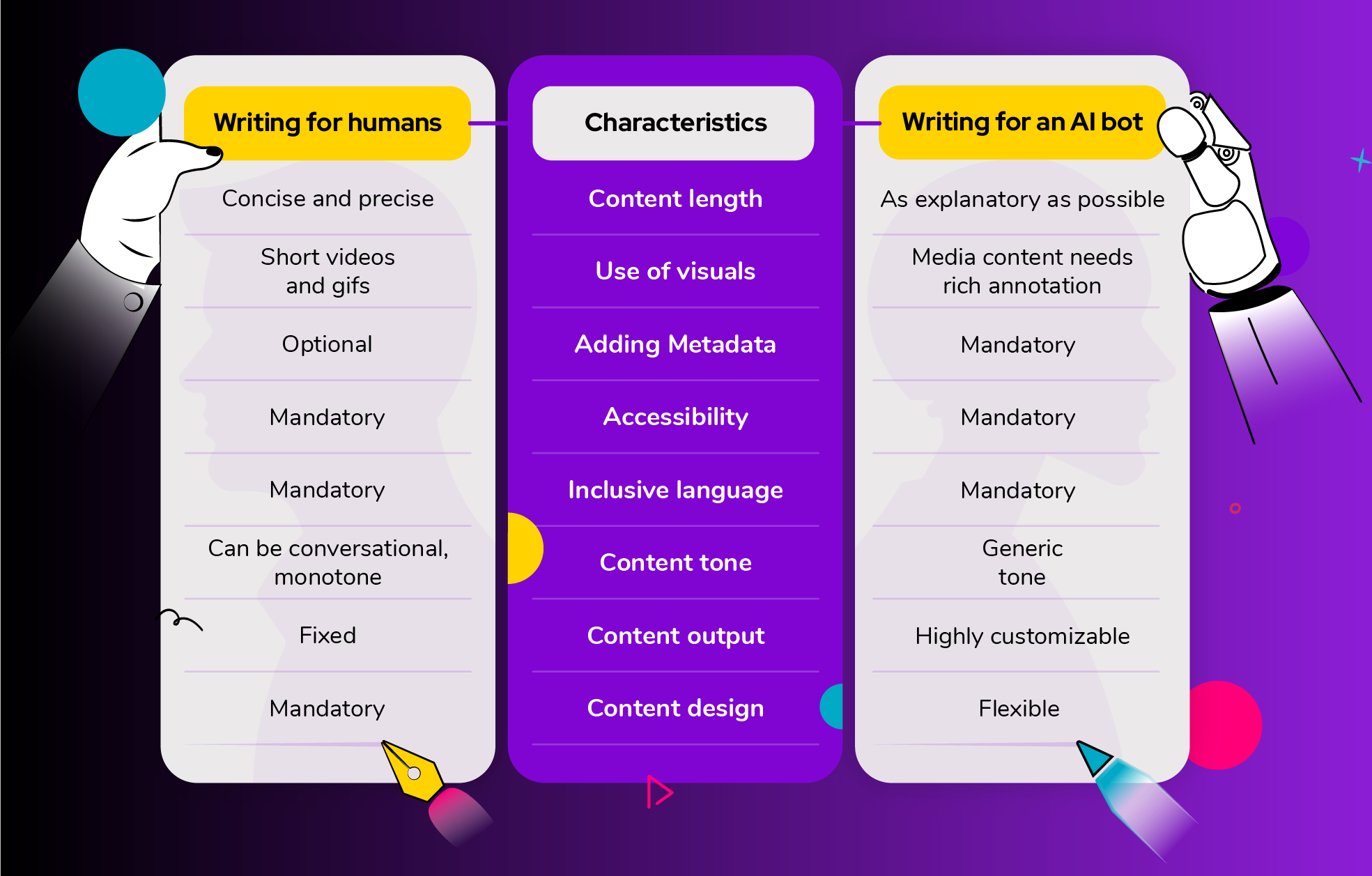It is obvious that technical writers write knowledge-based articles for customers and internal teams. The knowledge base article comes in a plethora of flavors such as software product features, user manuals, technical spec documents, configuration guides, procedures, and so on. Humans consume these knowledge base articles and take some actions!
This paradigm shift is occurring in how knowledge-base articles are created and consumed and how some actions are executed. This shift is being caused by the following technological trends and consumer behavior
- Consumers want to get things done quickly and will favor bots automating low-value mundane tasks
- Consumers want approximate answers to their “right” questions so that they can accomplish things faster
- The rise of Generative Artificial Intelligence (AI) simplifies knowledge discovery and content curation enabling non-technical consumers to adopt enterprise applications
- Increase in human trust in AI systems
In this blog, we shall explore how consumer behavior trends are going to impact the production of knowledge-base articles and how it will get utilized by consumers.
Change in Technical Writer Role
Given the technological shift happening quickly after the introduction of ChatGPT-4, technical writers and knowledge base providers are still assessing how this will impact their job role and technology platforms. However, there is a shift in consumer consumption trends in knowledge creation, discovery and consumption as detailed in the below image

Technical writers need to shift their thinking in producing any knowledge base content that is AI bot friendly and makes it easy for both AI bot and humans to comprehend. This is a radical shift in how technical writers produce content as they have been producing content predominantly for humans until now! In the future, technical writers will be producing new knowledge for AI bots, especially Generative AI technologies. However, the characteristics of writing for human consumption are extremely different from how to produce content for AI bots as explained in the below image

Also read: Importance of trust in adopting GenAI for knowledge base
Writing for Humans
When a technical writer composes a knowledge-based article, the content needs to be concise given the limitation of human attention span. The characteristics are dictated by biology, psychology, and cognitive capabilities. This translates to
- Most humans have shorter attention spans – This limits the content length to a certain number of words and constraints reading time
- Most humans prefer images and video for quick learning – This makes technical writers produce rich multimedia content such as screenshots, videos, and animated gifs
- Most humans prefer simple language – This constrains technical writers to use a small set of words and vocabulary to articulate complex ideas in simple words
- Humans are driven by emotions and ideology – The content needs to be inclusive and accessible to all humans. The content cannot exhibit any bias
Once the knowledge base article is consumed by a human, then they undertake certain activities as detailed in the knowledge base article. E.g if a software user reads about a product software feature in software documentation, then the software user might configure that software.
Also Read: Role of ChatGPT in Software Documentation
An intuitive software documentation tool to easily add your content and integrate it with any application. Give Document360 a try!
GET STARTED
Writing for an AI bot
Writing for an AI bot requires a mindset change on how technical writers create a new knowledge base article. An AI bot has unlimited computing power to synthesize new knowledge, unlimited storage to store huge volumes of information, and can interact with both humans and another AI bot!
Writing for an AI bot / Generative AI requires a different way of writing given the characteristics of the AI bot. This translates to
- Write content as explanatory as possible with a structure – Generative AI can summarize lengthy content into briefs and can explain complex ideas in simple terms
- Provide more examples on scenarios – Providing conversation-like scenarios with examples helps Generative AI technologies to consume this content easily
- Adding semantic metadata – Adding more metadata to annotate content enriches the content and augments the textual content
- Include FAQs – Writing FAQs helps with training Generative AI with a set of prompts (questions) with responses (answers)
- Maintain a business glossary – A list of all business terms along with definitions, nuances, assumptions, metrics, and so on
- Augmenting textual information with metadata – Adding metadata whether a particular action is an input to an interface or output of an interface helps Generative AI to know whether to seek intervention in case of automation of actions
- Related articles – A list of related articles from a technical writer’s point of view to the current articles
If technical writers produce AI-friendly content, then a customer can ask Generative AI what objective they wish to accomplish. Generative AI technologies such as ChatGPT, Bard and so on can provide precise steps. The bot technologies such as Robotic Process Automation (RPA), and intelligent automation via APIs will probably ask a customer whether it wants to complete those steps on their behalf!
Content Evaluation
Given that technical writers are going to produce content for AI bots, how we ensure that our current publicly available knowledge base contents are ready for Generative AI models to ingest and provide accurate answers based on our customers’ prompt? Large Language Models (LLMs) such as ChatGPT are trained on a large corpus of text taken from the open internet. If the LLMs need to use your knowledge base content, then those language models need to be fine-tuned. The fine-tuning of the LLMs requires giving a lot of prompts and responses as examples. This can be achieved through writing a lot of FAQs with questions and explanatory answers. Below is the list of steps for technical writers to repurpose their existing knowledge base to be AI-friendly
- Append more content to all your knowledge base articles with more explanations
- Add more metadata to both textual and multimedia elements
- Compile all business terms in a business glossary and use them consistently inside your knowledge base
- Produce a lot of FAQs with a lot of questions and laboratory answers
- Add “Related Articles” to all existing articles to establish a graphical connection between your content entities
- Review all your content to ensure that content is structured from H1 – H6
Metrics
Quantifying the efforts to make your knowledge base content helps with undertaking efforts to futureproof your existing knowledge base. Knowledge base platform vendors shall be building tools to help technical writers produce AI-friendly content. Below are some of the metrics that can help to get business stakeholders buy-in
- Number of words per article: 3000 – 5000 words
- Content structure compliance: H1 – H6
- FAQs per article: 10 – 20 FAQs
- Business glossary: 20 – 30 business terms
Read more: How Technical Writers can Utilize ChatGPT?
Conclusion
Generative AI is poised to dominate enterprise software. Given that Microsoft is embedding ChatGPT in every single enterprise product, it is prevalent among customers across the globe. Producing knowledge base content for ChatGPT will futureproof your investment in the existing knowledge base. Refactoring your existing knowledge base requires a change in the mindset of your technical writers. The characteristics of Generative AI technologies need to be taken into consideration while refactoring your existing knowledge base and when producing new knowledge content.
Now I can’t wait to live in an exciting world where Generative AI technologies provide an answer to my question via prompt and are also able to undertake actions on behalf of using bot technology!
Also read: Refactoring content for GenAI readiness: Best Practices and Guidelines
Schedule a demo with one of our experts to take a deeper dive into Document360
Book A Demo



 –
– 

